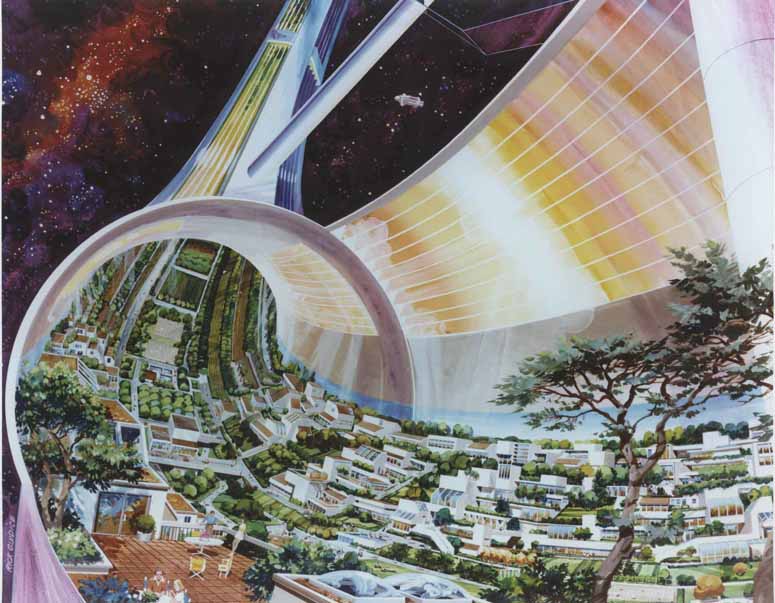 Thank you to Jack Varga (on Larch-L) for drawing attention to Nasa’s ideas on space colonies (see explanation and examples). They remind me of Sarah Eberle’s built example at the 2007 Chelsea Flower Show. But the Nasa examples are oddly suburban, as if humans would invest in travelling the universe to enjoy the delights of a modernist Levittown at high densities. Why would they need roofs if living in tubes? To protect from artificial rain? But it is probably correct that humans would soon tire of inter-galactic marvels and gaze instead at what the neighbours are up to – and that interest would help sustain tube life. It might in fact be a better idea to dispatch a spatter of tiny rockets containing only DNA, and this might be how life came to Planet Earth 3.5 billion years ago. My plea to Nasa is to send un-manned observatories into deep space – not humans.
Thank you to Jack Varga (on Larch-L) for drawing attention to Nasa’s ideas on space colonies (see explanation and examples). They remind me of Sarah Eberle’s built example at the 2007 Chelsea Flower Show. But the Nasa examples are oddly suburban, as if humans would invest in travelling the universe to enjoy the delights of a modernist Levittown at high densities. Why would they need roofs if living in tubes? To protect from artificial rain? But it is probably correct that humans would soon tire of inter-galactic marvels and gaze instead at what the neighbours are up to – and that interest would help sustain tube life. It might in fact be a better idea to dispatch a spatter of tiny rockets containing only DNA, and this might be how life came to Planet Earth 3.5 billion years ago. My plea to Nasa is to send un-manned observatories into deep space – not humans.

It is strange to see space looking remarkably like Earth. I wonder whether Bruneschelli designing in the 1800s [ http://www.destination360.com/europe/italy/florence/duomo ] would have imagined the 2000s producing Foster’s ‘Armadillo’ in Glascow?
[ http://www.flickr.com/photos/54549576@N00/3548739305 ]
Wiki lists myriad experiments on the International Space Station but not useful results from them, so it looks like money wasted to me. The one great result of the project is to illustrate the ‘delights’ of life on a space station. But I would enjoy a trip on Virgin Galactic, club class of course.
Awesome picture, and in a post-scarcity society where technology reduced the cost of manufacturing down next to nothing (mastery of manufacturing technology, personal manufacturing etc), this is the obvious answer to over-population. Maybe they’ve got concept pictures of coverd valleys on Mars holding in an artificial atmosphere and a thriving garden city? Very interesting blog by the way.
Personally, I think we should spend more time and effort looking after the miracles we’ve got here, on Earth, then trying to create a new one in space. What would be that for – just so we can have another one to destroy?
Fortuneately, many of the lessons learnt while pushing the boundaries of space exploration also give us a greater appreciation of what we have here on Earth.
We can only hope that today’s environmental crises imbues as all with an ongoing respectful attitude to our own planet as well as other planets.
As for population: the more you research population the more complex the situation becomes…what rate of growth is too little (think Japan and attempts to encourage population growth) and what rate of growth is too great (think China and attempts to limit population growth)?
A flight over North Asia leaves one with the impression that Earth has sufficient space to increase its population tenfold, as it has often done before, but I do not think this policy would be very fair to our ‘fellow creatures’.
Yes. The exploding human population has had devastating effects on our ‘fellow creatures’, not to mention the environment…Nor have we quite sorted out the lifestyle/economics question. I suppose that is why the concept of sustainable development has become popular.